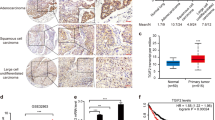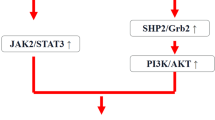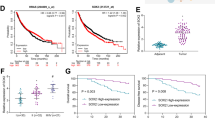Abstract
Cancer stem cells (CSCs) are a promising target for cancer therapy, particularly for metastatic lung cancers, but how CSCs are regulated is largely unknown. We identify two proteins, SLUG (encoded by SNAI2 gene) and SOX9, which are associated with advanced stage lung cancers and are implicated in the regulation of CSCs. Inhibition of either SLUG or SOX9 sufficiently inhibits CSCs in human lung cancer cells and attenuates experimental lung metastasis in a xenograft mouse model. Correlation between SLUG and SOX9 levels was observed remarkably, we therefore sought to explore their mechanistic relationship and regulation. SLUG, beyond its known function as an epithelial–mesenchymal transition transcription factor, was found to regulate SOX9 by controlling its stability via a post-translational modification process. SLUG interacts directly with SOX9 and prevents it from ubiquitin-mediated proteasomal degradation. SLUG expression and binding are necessary for SOX9 promotion of lung CSCs and metastasis in a mouse model. Together, our findings provide a novel mechanistic insight into the regulation of CSCs via SLUG-SOX9 regulatory axis, which represents a potential novel target for CSC therapy that may overcome cancer chemoresistance and relapse.
This is a preview of subscription content, access via your institution
Access options
Subscribe to this journal
Receive 50 print issues and online access
$259.00 per year
only $5.18 per issue
Buy this article
- Purchase on Springer Link
- Instant access to full article PDF
Prices may be subject to local taxes which are calculated during checkout






Similar content being viewed by others
References
Esposito L, Conti D, Ailavajhala R, Khalil N, Giordano A . Lung cancer: are we up to the challenge? Curr Genomics 2010; 11: 513–518.
Crino L, Weder W, van Meerbeeck J, Felip E . Early stage and locally advanced (non-metastatic) non-small-cell lung cancer: ESMO Clinical Practice Guidelines for diagnosis, treatment and follow-up. Ann Oncol 2010; 21: V103–V115.
Riihimaki M, Hemminki A, Fallah M, Thomsen H, Sundquist K, Sundkist J et al. Metastatic sites and survival in lung cancer. Lung Cancer 2014; 86: 78–84.
Al-Hajk M, Wicha MS, Benito-Hernandez A, Morrison SJ, Clarke MF . Prospective identification of tumorigenic breast cancer cells. Proc Natl Acad Sci USA 2003; 100: 3983–3988.
Dalerba P, Dylla SJ, Park IK, Liu R, Wang X, Cho RW et al. Phenotypic characterization of human colorectal cancer stem cells. Proc Natl Acad Sci USA 2007; 104: 10158–10163.
Ho MM, Ng AV, Lam S, Hung JY . Side population in human lung cancer cell lines and tumors is enriched with stem-like cancer cells. Cancer Res 2007; 67: 4827–4833.
Bonnet D, Dick JE . Human acute myeloid leukemia is organized as a hierarchy that originates from a primitive hematopoietic cell. Nat Med 1997; 3: 730–737.
Singh SK, Hawkins C, Clarke ID, Squire JA, Bayani J, Hide T et al. Identification of human brain tumor initiating cells. Nature 2004; 432: 396–401.
Luanpitpong S, Wang L, Castranova V, Rojanasakul Y . Induction of stem-like cells with malignant properties by chronic exposure of human lung epithelial cells to single-walled carbon nanotubes. Part Fibre Toxicol 2014; 11: 22.
Malanchi I, Santamaria-Martinez A, Susanto E, Peng H, Lehr HA, Delaloye JF et al. Interactions between cancer stem cells and their niche govern metastatic colonization. Nature 2012; 481: 85–89.
Charafe-Jauffret E, Ginestier C, Iovino F, Tarpin C, Diebel M, Esterni B et al. Aldehyde dehydrogenase 1-positive cancer stem cells mediate metastasis and poor clinical outcome in inflammatory breast cancer. Clin Cancer Res 2010; 16: 45–55.
Silva IA, Bai S, McLean K, Yang K, Griffith K, Thomas D et al. Aldehyde dehydrogenase in combination with CD133 defines angiogenic ovarian cancer stem cells that portend poor patient survival. Cancer Res 2011; 71: 3991–4001.
Tan Y, Chen B, Xu W, Zhao W, Wu J . Clinicopathological significance of CD133 in lung cancer: a meta-analysis. Mol Clin Oncol 2014; 2: 111–115.
Tsai JH, Yang J . Epithelial-mesenchymal plasticity in carcinoma metastasis. Genes Dev 2013; 27: 2192–2206.
Nurwidya F, Takahashi F, Murakami A, Takahashi K . Epithelial mesencymal transition in drug resistance and metastasis of lung cancer. Cancer Res Treat 2012; 44: 151–156.
Nieto MA . The snail superfamily of zinc-finger transcription factors. Nat Rev Mol Cell Biol 2002; 3: 155–166.
Shih JY, Tsai MF, Chang YL, Yuan A, Yu CJ, Lin SB et al. Transcription repressor Slug promotes carcinoma invasion and predicts outcome of patients with lung adenocarcinoma. Clin Cancer Res 2005; 11: 8070–8078.
Shih JY, Yang PC . The EMT regulator Slug and lung carcinogenesis. Carcinogenesis 2011; 32: 1299–1304.
Philips S, Prat A, Sedic M, Proia T, Wronski A, Mazumdar S et al. Cell-state transitions regulated by SLUG are critical for tissue regeneration and tumor initiation. Stem Cells Rep 2014; 2: 633–647.
Ben-Porath I, Thomson MW, Carey VJ, Ge R, Bell GW, Regev A et al. An embryonic stem cell-like gene expression signature in poorly differentiated aggressive human tumors. Nat Genet 2008; 40: 499–507.
Cronin JC, Watkins-Chow DE, Incao A, Hasskamp JH, Schonewolf N, Aoude LG et al. SOX10 ablation arrests cell cycle, induces senescence, and suppresses melanomagenesis. Cancer Res 2013; 73: 5709–5718.
Lefebvre V, Dumitrui B, Penzo-Mendez A, Han Y, Pallavi B . Control of cell fate and differentiation by Sry-related high mobility-group box (Sox) transcription factors. Int J Biochem Cell Biol 2007; 39: 2195–2214.
Turcatel G, Rubin N, Menke DB, Martin G, Shi W, Warburton D . Lung mesenchymal expression of Sox9 plays a critical role in tracheal development. BMC Biol 2013; 11: 117.
Jiang SS, Fang WT, Hou YH, Huang SF, Yen BL, Chang JL et al. Upregulation of SOX9 in lung adenocarcinoma and its involvement in the regulation of cell growth and tumorigenicity. Clin Cancer Res 2010; 16: 4363–4373.
Levina V, Marrangoni AM, DeMarco R, Gorelik E, Lokshin AE . Drug-selected human lung cancer stem cells: cytokine network, tumorigenic and metastatic properties. PLoS One 2008; 3: e3077.
Dontu G, Abdallah WM, Foley JM, Jackson KW, Clarke MF, Kawamura MJ et al. In vitro propagation and transcriptional profiling of human mammary stem/progenitor cells. Genes Dev 2003; 17: 1253–1270.
Guo W, Keckesova Z, Donaher JL, Shibue T, Tischler V, Reinhardt F et al. Slug and Sox9 cooperatively determine the mammary stem cell state. Cell 2012; 148: 1015–1028.
Hermann PC, Huber SL, Herrler T, Aicher A, Ellwart JW, Guba M et al. Distinct populations of cancer stem cells determine tumor growth and metastatic activity in human pancreatic cancer. Cell Stem Cell 2007; 1: 313–323.
Darnell GA, Antallis TM, Johnstone RW, Stringer BW, Ogbourne SM, Harrich D et al. Inhibition of retinoblastoma protein degradation by interaction with the serpin plasminogen activator inhibitor 2 via a novel consensus motif. Mol Cell Biol 2003; 23: 6520–6532.
Zheng Y, Wang B, Jayappa KD, Yao X . Host protein Ku70 binds and protects HIV-1 integrase from proteasomal degradation and is required for HIV replication. J Biol Chem 2011; 286: 17722–17735.
Luanpitpong S, Chanvorachote P, Stehlik C, Tse W, Callery PS, Wang L et al. Regulation of apoptosis by Bcl-2 cysteine oxidation in human lung epithelial cells. Mol Cell Biol 2013; 24: 858–869.
Korolchuk VI, Mansilla A, Menzies FM, Rubinsztein DC . Autophagy inhibition compromises degradation of ubiquitin-proteasome pathway substrates. Mol Cell 2009; 33: 517–527.
Bhattacharya S, Yu H, Mim C, Matouschek A . Regulated protein turnover: snapshots of the proteasome in action. Nat Rev Mol Cell Biol 2014; 15: 122–133.
Mani A, Gelmann EP . The ubiquitin-proteasome pathway and its role in cancer. J Clin Oncol 2005; 23: 4776–4789.
Lam YA, Lawson TG, Velayutham M, Zweier JL, Pickart CM . A proteasomal ATPase subunit recognizes the polyubiquitin degradation signal. Nature 2002; 416: 763–767.
Krueger KE, Srivastava S . Posttranslational protein modifications: current implications for cancer detection, prevention, and therapeutics. Mol Cell Proteomics 2006; 5: 1799–1810.
Yang Y, Ludwig RL, Jensen JP, Pierre SA, Medaglia MV, Davydov IV et al. Small molecule inhibitors of HDM2 ubiquitin ligase activity stabilize and activate p53 in cells. Cancer Cell 2005; 7: 547–559.
Bhat-Nakshatri P, Appaiah H, Ballas C, Pick-Franke P, Goulet R Jr, Badve S et al. SLUG/SNAI2 and tumor necrosis factor generate breast cells with CD44+/CD24- phenotype. BMC Cancer 2010; 10: 411.
Rockich BE, Hrycaj SM, Shih HP, Nagy MS, Ferguson MA, Kopp JL et al. Sox9 plays multiple role in the lung epithelium during branching morphogenesis. Proc Natl Acad Sci USA 2013; 110: E4456–E4464.
Ding GX, Liu J, Feng CC, Jiang HW, Xu JF, Ding Q . Slug regulates cyclin D1 expression by ubiquitin-proteasome pathway in prostate cancer cells. Panminerva Med 2012; 54: 219–223.
Hasan MR, Sharma R, Saraya A, Chattopadhyay TK, DattaGupta S, Walfish PG et al. Slug is a predictor of poor prognosis in esophageal squamous cell carcinoma patients. PLoS One 2013; 8: e82846.
Cates JM, Byrd RH, Fohn LE, Tatsas AD, Washington MK, Black CC . Epithelial-mesenchymal transition markers in pancreatic ductal adenocarcinoma. Pancreas 2009; 38: e1–e6.
Chakravarty G, Moroz K, Makridakis NM, Lloyd SA, Galvez SE, Canavello PR et al. Prognostic significance of cytoplasmic SOX9 in invasive ductal carcinoma and metastatic breast cancer. Exp Biol Med 2011; 236: 141–155.
Chakravarty G, Rider B, Mondal D . Cytoplasmic compartmentalization of SOX9 abrogates the growth arrest response of breast cancer cells that can be rescued by trichostatin A treatment. Cancer Biol Ther 2011; 11: 71–83.
Dikic I, Wakatsuki S, Walters KJ . Ubiquitin-binding domains-from structures to functions. Nat Rev Mol Cell Biol 2009; 10: 659–671.
Levina V, Marrangnoi A, Wang T, Parikh S, Su Y, Herberman R et al. Elimination of human lung cancer stem cells through targeting of the stem cell factor–c- kit autocrine signaling loop. Cancer Res 2010; 70: 338–346.
Stewart SA, Dykxhoorn DM, Palliser D, Mizuno H, Yu EY, An DS et al. Lentivirus-delivered stable gene silencing by RNAi in primary cells. RNA 2003; 9: 493–501.
Kajita M, McClinic KN, Wade PA . Aberrant expression of the transcription factors snail and slug alters the response to genotoxic stress. Mol Cell Biol 2004; 24: 7559–7566.
Xu Z, Gao X, He Y, Ju J, Zhang M, Liu R et al. Synergistic effect of SRY and its direct target, WDR5, on Sox9 expression. PLoS One 2012; 7: e34327.
Acknowledgements
This work was supported by grants from the National Institutes of Health (NIH; R01-ES022968), National Science Foundation (CBET-1434503) and Mary Babb Randolph Cancer Center (MBRCC) Sara C Allen Lung and James F Allen Comp Lung Cancer Research Fund. Flow cytometric analysis was performed in the WVU Flow Cytometry Core Facility, which is supported in part by the NIH Grant P30 GM103488. Animal experiments were performed in the WVU Animal Models and Imaging Facility, which is supported in part by the MBRCC and NIH Grants P20 RR016440, P30 RR032138/GM103488 and S10 RR026378. We would like to acknowledge the WVU Pathology Laboratory for Translational Medicine for tissue sectioning and staining services and Drs Davor Solter and Barbara Knowles for their comments on the manuscript. The findings and conclusions in this report are those of the authors and do not necessarily represent the views of the National Institute for Occupational Safety and Health.
Author information
Authors and Affiliations
Corresponding authors
Ethics declarations
Competing interests
The authors declare no conflict of interest.
Additional information
Supplementary Information accompanies this paper on the Oncogene website
Supplementary information
Rights and permissions
About this article
Cite this article
Luanpitpong, S., Li, J., Manke, A. et al. SLUG is required for SOX9 stabilization and functions to promote cancer stem cells and metastasis in human lung carcinoma. Oncogene 35, 2824–2833 (2016). https://doi.org/10.1038/onc.2015.351
Received:
Revised:
Accepted:
Published:
Issue Date:
DOI: https://doi.org/10.1038/onc.2015.351
This article is cited by
-
Photobiomodulation Facilitates Rat Cutaneous Wound Healing by Promoting Epidermal Stem Cells and Hair Follicle Stem Cells Proliferation
Tissue Engineering and Regenerative Medicine (2024)
-
Ubiquitin-specific protease 28: the decipherment of its dual roles in cancer development
Experimental Hematology & Oncology (2023)
-
TMPRSS4, a type II transmembrane serine protease, as a potential therapeutic target in cancer
Experimental & Molecular Medicine (2023)
-
SOX9 drives KRAS-induced lung adenocarcinoma progression and suppresses anti-tumor immunity
Oncogene (2023)
-
Strategies for understanding the role of cellular heterogeneity in the pathogenesis of lung cancer: a cell model for chronic exposure to cigarette smoke extract
BMC Pulmonary Medicine (2022)



